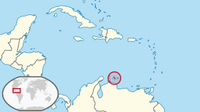Difference between revisions of "Curaçao"
| Line 12: | Line 12: | ||
[[File:Curacao1791-cropped.jpg|800px]] | [[File:Curacao1791-cropped.jpg|800px]] | ||
<p>See [https://en.wikipedia.org/wiki/Cura%C3%A7ao Wikipedia]</p> | <p>See [https://en.wikipedia.org/wiki/Cura%C3%A7ao Wikipedia]</p> | ||
| − | <p>Curaçao began as an anchorage for tradeships, but quickly grew into a sizable city governed by rich tradesmen. Soon the large companies own land there, and Curaçao becomes the major trading port on the Spanish Main. Here trading and smuggling earn a reputation that anything can be acquired for the right price.</p> | + | <p>Curaçao began as an anchorage for tradeships, but quickly grew into a sizable city governed by rich tradesmen. Soon the large companies own land there, and Curaçao becomes the major trading port on the Spanish Main. Here trading and smuggling earn a reputation that anything can be acquired for the right price; Spanish produce smuggled from everywhere along the Main is bought here by Dutch merchants, who happily exchange it for European products that can be profitably smuggled to the Spanish.</p> |
=History= | =History= | ||
Revision as of 19:49, 26 December 2022
| Curaçao | ||||||||||||

| ||||||||||||
| ||||||||||||

|
See Wikipedia
Curaçao began as an anchorage for tradeships, but quickly grew into a sizable city governed by rich tradesmen. Soon the large companies own land there, and Curaçao becomes the major trading port on the Spanish Main. Here trading and smuggling earn a reputation that anything can be acquired for the right price; Spanish produce smuggled from everywhere along the Main is bought here by Dutch merchants, who happily exchange it for European products that can be profitably smuggled to the Spanish.
Contents
History
The tale of this island is as old as the civilization in the Caribbean itself. The Spanish explorer, Alonso de Ojeda, landed here in 1499 while searching for the legendary ‘El Dorado’. Finding no gold, his men settled cattle farms along the southern coast of the island. The native tribes, known as the Arawak, were easily subdued by a combination gunpowder or disease.
In 1634, with Spanish power dwindling, Dutch merchants fund a trade center in the natural harbor, creating the ‘city’ of Curaçao. Various names for the new city, like ‘Willemstad’ (a prominent backer of the enterprise) and ‘Schottegat’ (the name of the harbor itself) are debated, but as ‘curacao’ holds a double-meaning (‘land of the giants’ in Spanish, in reference to the tall natives, ‘heart’ in Portuguese, in reference to it being a center for trading), the appeal of a name in multiple languages (and thusly as many merchants as possible) just makes good business, and so makes good sense, and ‘Curaçao’ becomes synonymous with island and city.
Due to the arid land here, agriculture isn’t at all profitable, so the pioneers (most of them Jewish families from Amsterdam and Brazil) begin trading in cotton, indigo, tobacco and slaves. This island-city quickly rises to prominence as a major center for trade. The Dutch West India Company makes it their unofficial base of operations throughout the New World, employing all manner of good sense (and business tactics) to secure their place.
The slave trade becomes the island-city’s most profitable trade, peaking in 1662. Not only are the natives sold here, but slaves imported from Africa are brought here for their distribution throughout the Caribbean to friendly colonies. It is not long before European rebels suffer the same fate in the city’s hastily dug dungeons. Strangely, only pirates remain exempt. Strange, at least, to the rest of the world, who doesn’t face the constant threat of the Spanish turning one wrong ledger into a declaration of war—plentiful pirates keep the city fortified as well as draw Spanish ships away to pursue them.
Government
The city is run by tradesmen first and foremost, whether officially or not. Laws can be changed as easily as figures on an invoice, if it’s what is best for business. The Dutch West India Company holds all the true power here.
